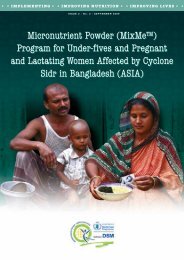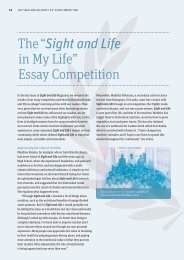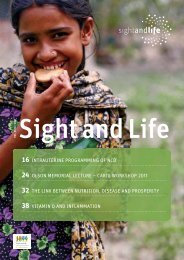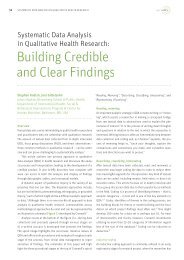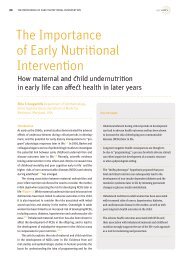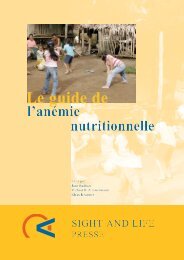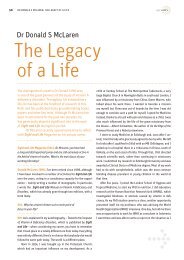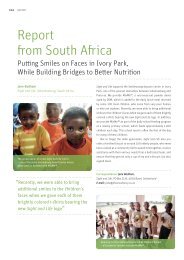Sight and Life Magazine 1/2011
Sight and Life Magazine 1/2011
Sight and Life Magazine 1/2011
Create successful ePaper yourself
Turn your PDF publications into a flip-book with our unique Google optimized e-Paper software.
56 OPINION 1 / 2depending upon species type <strong>and</strong> experimental conditions. NotingDavid’s cited implications of some clostridia with IBD, thisstory could have an added twist. Research has shown elevatedlevels of microbially generated sulphides in the fecal stream ofulcerative colitis (UC) sufferers (one of two major types of IBD). 4Above a certain level, sulphides are destructive to colonocytefunction, resulting in typical inflammatory patterns of UC. Theyare also volatile, <strong>and</strong> can be rendered innocuous by binding tometals – such as iron!Correspondence: Glenn Gibson, Department of Food <strong>and</strong>Nutritional Sciences, University of Reading, Whiteknights, PO Box217, Reading, Berkshire, RG6 6AH, United KingdomE-mail: g.r.gibson@reading.ac.ukReferences01. Martin FP, Sprenger N, Montoliu I et al. Dietary modulation of gutfunctional ecology studied by fecal metabonomics. J Proteome Res2010; 9:5284–529502. Zimmermann MB, Chassard C, Rohner F et al. The effects of ironfortification on the gut microbiota in African children: a r<strong>and</strong>omizedcontrolled trial in Cote d’Ivoire. Am J ClinNutr 2010; 92:1406–1415.03. Saulnier DM, KolidaS, Gibson GR. Microbiology of the human intestinaltract <strong>and</strong> approaches for its dietary modulation. Curr PharmDesign 2009;15:1403–1444.04. Rowan FE, Docherty NG, Coffey JC et al. Sulphate-reducing bacteria<strong>and</strong> hydrogen sulphide in the aetiology of ulcerative colitis. Br JSurg 2009;96:151–158.Opinion 2: Venturing into the Jungle of MultipleInteractions between Iron, Modulating Influences,<strong>and</strong> Human HealthKlaus SchuemannTechnische Universität München, Zentralinstitutfür Ernährung und Lebenswissenschaften, GermanyOver the last 10 years it has become a truism that iron is a double-edgedsword. It is essential for bacteria, parasites <strong>and</strong> hostorganisms, but can also cause oxidative damage. Dr Thurnham’scontribution is on the crest of present day efforts to widen thescope from such direct iron effects to the increasing number ofmutual interactions <strong>and</strong> cross-talks, such as those between iron,the composition of intestinal flora, <strong>and</strong> the well-being of thehost. We congratulate <strong>Sight</strong> <strong>and</strong> <strong>Life</strong> on recognizing this newtrend <strong>and</strong> inviting this article.We must stay aware, however, that the subject under discussionhere is only the tip of an iceberg which might be termed“modulation of health-related iron effects.” Some examplesmay illustrate how complex the scene has become. Extracellularbacteria, indeed, merrily hijack each other’s iron-fishing siderophoresby imitating the siderophore-receptors of competingspecies. The host organism does the same in trying to recuperatepart of its iron. Playing this game more or less successfullymodulates the expansion of, for example, pathogenic germs <strong>and</strong>thus the prevalence of corresponding disease. Some bacteriaeven hijack entire heme molecules to an extent permitting themto abolish endogenous heme biosynthesis. 1Another major player in the multidimensional contest foriron supplies is the host’s homeostatic regulation of iron-absorption<strong>and</strong> distribution kinetics. 2 In the Pemba trial, 3 irondeficientchildren profited from iron supplementation, whileiron-adequate children suffered from more severe clinical malariacourses. This may seem paradoxical at first glance, as theabsorption of potentially harmful iron increases iron deficiency.However, iron drainage to hematopoiesis seems to be increasedto an even higher extent in terms of iron deficiency, so that lessiron circulates with the plasma.By contrast, iron concentration in the gut lumen is not homeostaticallyregulated. It depends on iron ingestion <strong>and</strong> inducesoxidative stress, the extent of which is modulated by dietaryantioxidants. The results of this interaction can be determinedin the stool. 4 Correspondingly, low dietary iron content reducedthe extent of Crohn-like intestinal bowel disease in a murinemodel. 5 This concurred with increases in endoplasmic reticulum(ER) stress in the ileal mucosa such as the impaired regulation



